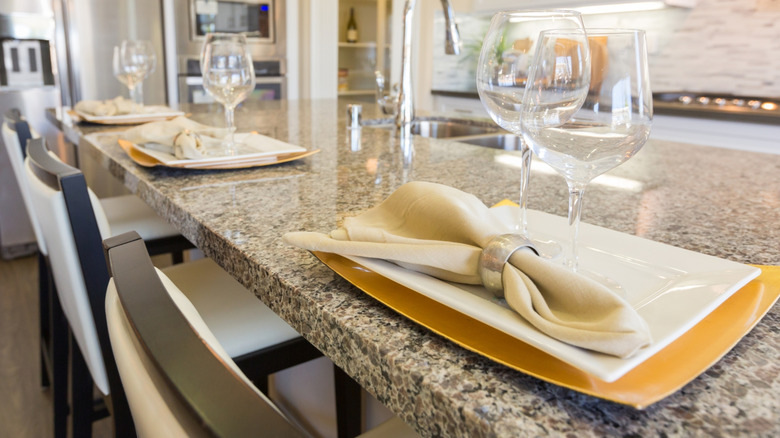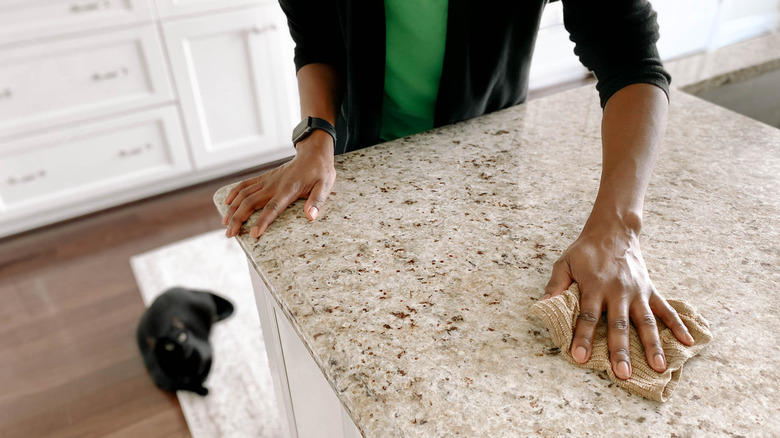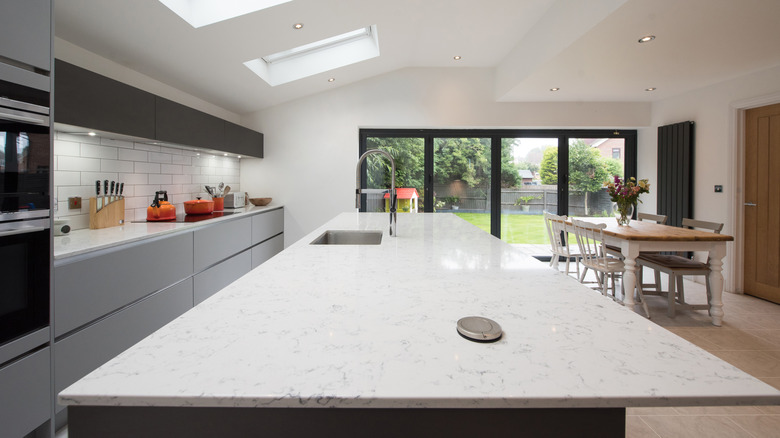Are Granite Countertops No Longer In Style? There May Be A More Popular Option For Your Kitchen
Once upon a time and not so very long ago, granite countertops were all the rage. But the fickle design world is being fickle once again. As old-school kitchen trends are elbowing out the newer kids, including through a resurgence of vintage kitchen appliances, changes have also been brewing for a while in the realm of kitchen countertops. The counter material that once reigned supreme has fallen far below other options, and quartz is chief among the products that have unseated granite as the fairest choice in all the land.
Gazing backward in the interior design rearview, granite countertops were once a luxury product that only those with big budgets could afford to install. This, naturally, made them the sought-after option and a mark of elite design. But gradually, granite countertops went from an exclusive product to a standard one. Suddenly, everybody had granite in their kitchens, and it became a builder-grade option that was readily available for purchase through home improvement stores. Thus, the former belle of the ball had danced with just about everybody and was no longer an exclusive, sought-after rarity.
Enter burgeoning products like quartz. When kitchen design is being discussed on a home remodeling show, it's almost always quartz that is being shopped for and installed these days. The look of granite — especially the dark, busy patterns that were once highly popular — is now largely considered passé among designers and consumers. Part of this migration in preference is just the natural consequence of changing trends, but on the practical side of things, quartz boasts some very specific qualities that have made it a more desirable option than granite.
The rise and fall of granite
A natural stone product, granite took hold as a mainstay in American design in the mid-'90s and early 2000s. Importing the product became easier, more countries started producing it, and technologies for working with it improved — making granite both more accessible and more affordable. But the design capabilities of granite, in terms of aesthetic, are limited in the sense that the stone is formed in set patterns and colors and isn't customizable. This can make it challenging to find a granite slab that matches a color scheme, requiring more effort in the way of shopping around.
It's also a common tale of buyer's remorse for homeowners to think they like a granite piece, only to find they hate it when it's actually installed. There are a couple of reasons this happens. One is a countertop shopper can see a piece of granite in a showroom or model home, think it's the granite of their dreams, and order it — only to find the final, installed countertop looks nothing like what they envisioned. That's because, unlike a cut of carpet that's uniform throughout the entire product roll, a slab of granite has naturally formed, unique variables that frequently make one slab look drastically different from another despite having the same product number and being sourced from the same stone quarry. For this reason, picking granite based on a small sample or cursory side view in a showroom doesn't give shoppers the full picture. If a homeowner doesn't see the complete, actual slab slated to go into their specific house, there are almost always post-installation surprises, and they're not always pleasant.
Superior qualities that have made quartz more popular
Unlike granite, quartz isn't a completely natural product. It's only partially composed of natural quartz, with the rest of its makeup consisting of polymer resins. The manufactured state of quartz makes it customizable, allowing homeowners a great deal more design freedom in terms of choosing colors, patterns, and finishes. In fact, the advent of printed quartz countertop technology has made virtually any desired design a possibility. Through high-resolution digital printing, quartz products can be made to look like any kind of natural stone or other surface material, with customized marbling, coloring, patterning, and artistic designs tailorable to a customer's wishes.
Beyond aesthetics, quartz's popularity is also due to the fact that it's more robust, durable, and low-maintenance than granite, and normal cleaning is its only needed upkeep. In contrast, granite is more susceptible to staining, chipping, or breakage, and needs to be sealed regularly. Many recommend annual resealing because it's porous and, therefore, vulnerable to staining, retaining bacteria, and being damaged by chemicals and acidic substances like citrus juices. Nonporous quartz, on the other hand, doesn't stain or need sealing treatments or other maintenance, is considered much more sanitary because it doesn't harbor bacteria, and stands up better against cracking and breakage.
It's clear the winner in this war of kitchen-tops is quartz — at least for now. The winds of design change are ever blowing, and other countertop products like wood, marble, concrete, porcelain, and stainless steel — on par with the rising popularity of metallic accents in the kitchen — are also trending.



